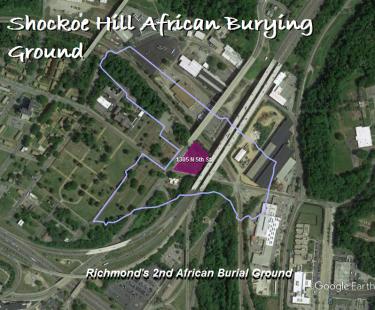Shockoe Hill African Burying Ground
Visit WebsiteAbout
The Shockoe Hill African Burying Ground was established by the city of Richmond in 1816 for the interment of free people of color, and the enslaved. It is Richmond's 2nd African Burial Ground, and was the replacement for the older African Burial Ground in Shockoe Bottom. Over 22,000 people of African descent were buried within its 31 acres. It is likely the largest burial ground for free people of color and the enslaved in the United States. The Shockoe Hill African Burying ground has suffered many abuses, from grave robbery for the medical colleges, primarily the University of Virginia and the Medical College of Virginia (now VCU), to being divided up and having streets, a railroad, and I-64 run through its grounds. An abandoned gas station and a highway billboard located at 1305 North 5th St. were constructed at the heart of the burial ground, where it's original 2 acres are located (titled on the 1816 plan as the "Burying Ground for Free People of Colour" and the "Burying Ground for Negroes"). The invisible Shockoe Hill African Burying Ground (a segregated part of the Shockoe Hill Cemetery) was purposely made to disappear from the visible landscape. For the last few years advocates led by a descendant, have worked tirelessly to restore it both to history and to memory. In 2021 it was added to Preservation Virginia's list of most endangered historic places. That same year the city of Richmond reclaimed 1.2 acres of the original 1816 burial ground. On March 17, 2022 the Shockoe Hill Burying Ground Historic District (which includes the Shockoe Hill African Burying Ground) was added to the Virginia Landmarks Register. On June 12, 2022 an historic highway marker for the Shockoe Hill African Burying Ground was unveiled at 1305 N 5th St. Then on June 16, 2022, the National Parks Service added the Shockoe Hill Burying Ground Historic District to the National Register of Historic Places. Though important progress for the recognition of the burial ground is being made, it remains endangered.
